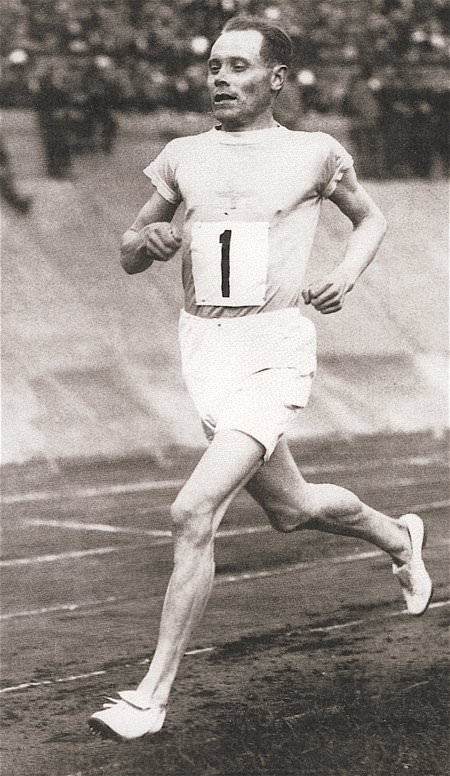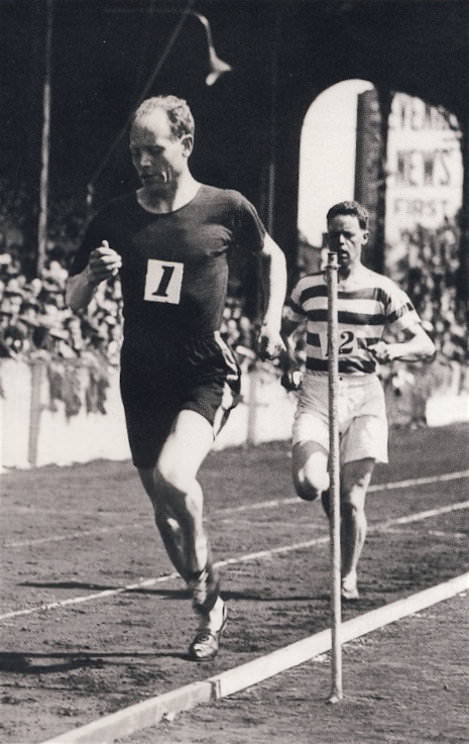PROFILE: PAAVO NURMI
1897-1973
Finnish runner Paavo Nurmi was truly a legend in his own lifetime. In the 1920s he was by far the dominant distance runner in the world. He improved world records by the following margins: 1,500: 2.1 seconds; Mile: 2.2 seconds; 3,000: 12.8 seconds; 5,000: 8.4 seconds; 10,000: 52.6 seconds. Nurmi also broke new ground in racing and training techniques. In his training he developed an ability to judge his speed. He understood the need to run at an even pace when attacking records and carried a stopwatch in his races. He trained twice a day and did some speedwork. Later, he admitted that he did too much steady running at the expense of fast intervals.
Nevertheless, in the 1924 Olympics Nurmi won the 1500, the 5000 and the Cross-Country. Although not so successful in the 1928 Olympics, he still won one gold and two silver medals. Overall, he won 12 Olympic medals. Following his trail-blazing example, Finnish runners went on to dominate distance running until WW2, taking five of the nine distance medals in the 1932 and 1936 Olympics, although none was as dominant on the world scene as Nurmi had been.
 |
Nurmi was an early starter, joining his local club when 10 and starting proper training when 15. But at that time he had no idea of the need for speed work and trained only in summer. He came from a poor family and was sent out to work as a delivery boy from age 13. Like many great runners, he endured some hard physical labour during his formative years: “I was an errand boy for a wholesale firm and had to deliver by pushcart, as was customary in those days. I shed much sweat in taking merchandise hundreds of times up the steeply rising street to the Turku railway station. The strength of my back and legs dates from that time.” (Wilt, How They Train, p.65)
Once in the Military at 21, he had more time to train. The next year in the 1920 Olympics he won his first Olympic medals: golds in the 10,000, Cross-Country and the Team competition, and a silver in the 5,000. Until 1924 his training comprised of a daily morning walk and an afternoon run, but only from April to September. This training earned him the World Mile Record of 4:10.4. Before this race he had said he would run 4:10. He was well known for saying before a race, “I’m going to run a time of…. If someone else runs faster, he’ll win.” (The Will of Olympic Champions, transl H Lehmusvuori.)
In 1924 Nurmi added an extra daily run to his training schedule. His workouts became much more intense. In the morning he did a 10-12K walk with a few sprints and then gym work. On the track an hour later he would do 4-5 80-100 sprints, a fast 400-1,000 for time and then 3,000 to 4,000 at even speed with fast last lap. Finally in the evening, he ran 4K to 7K cross-country, the last 1K to 2K at a faster speed. After this he finished with 4-5 sprints of 80-100m. (Wilt, How They Train, p. 66) This new training, which now included much more speed work, prepared him for his 1924 Olympic triumphs.
1924 was a great year for Paavo Nurmi. He injured a knee badly in the spring and only came to form at the last moment. A problem with the Olympic schedule was that the 1,500 and 5,000 finals were only 55 minutes apart. He tried this schedule at an earlier meet, running 3:52.6 (WR) and 14:28.2 (WR). In the Olympics 1,500 he ran the first 1,000 in 2:31. He was so far ahead that he finished easily in 3:53.6. In the 5,000 he shadowed Ritola until the last straight and won by a meter. Then he went on to win two more golds in Cross-Country and the 3,000 team race.
 |
| Nurmi checking the stopwatch that he always carried in races. |
At the end of 1924 he had WRs for 1,500, Mile, 2,000, 3000, 5,000 and 10,000. This was the peak of his career. Although he broke the 2,000 and 3,000 WRs in the next two years, he didn’t break his world records in the standard distances. One of the reasons for this was likely his hectic USA tour in 1925, when he ran 55 races across the continent. As his speed diminished, he focused on longer distances.
By the time of the 1928 Olympics he was no longer invincible. He was only second in the 3,000 Steeplechase and 5,000, but he did win the 10,000 in 30:18.8, some 12 seconds slower than his 1924 WR.
Nurmi continued to compete and went to Los Angeles Olympics in 1932 to run the Marathon. However, a few days before the Games, he was ruled guilty of professionalism by the IAAF. He watched the Games from the stands. In actual fact he might well have been unable to run as he had picked up an injury while running his first marathon in the Finnish trials.
Despite the IAAF ruling, Nurmi was allowed to compete in Finland as an amateur in 1933, when he won the Finnish 1,500 title. He ran his last race on September 16, 1934. Following his retirement, Nurmi built up a construction company and became a rich man. He remained a celebrity throughout his life and was chosen to carry the torch in the stadium for the 1952 Olympics in Helsinki. 
Good article: “Nurmi on Nurmi,” an interview with Nurmi’s son Matti. www.iaaf.org/news/printer,newsid=31592.htmx
3 Comments